Negligence Cases Analysis
VerifiedAdded on 2020/03/02
|7
|1478
|124
AI Summary
This assignment requires students to analyze two negligence cases, one involving Aurora who was injured by a faulty tool from MacTools Ltd., and another involving Jessie whose vase broke due to a power outage potentially caused by MacTools Ltd. Students must examine the elements of negligence, duty of care, foreseeability, and apply legal precedents like Wyong Shire Council v Shirt and Froom v Butcher to determine if a successful negligence claim can be made in each case.
Contribute Materials
Your contribution can guide someone’s learning journey. Share your
documents today.
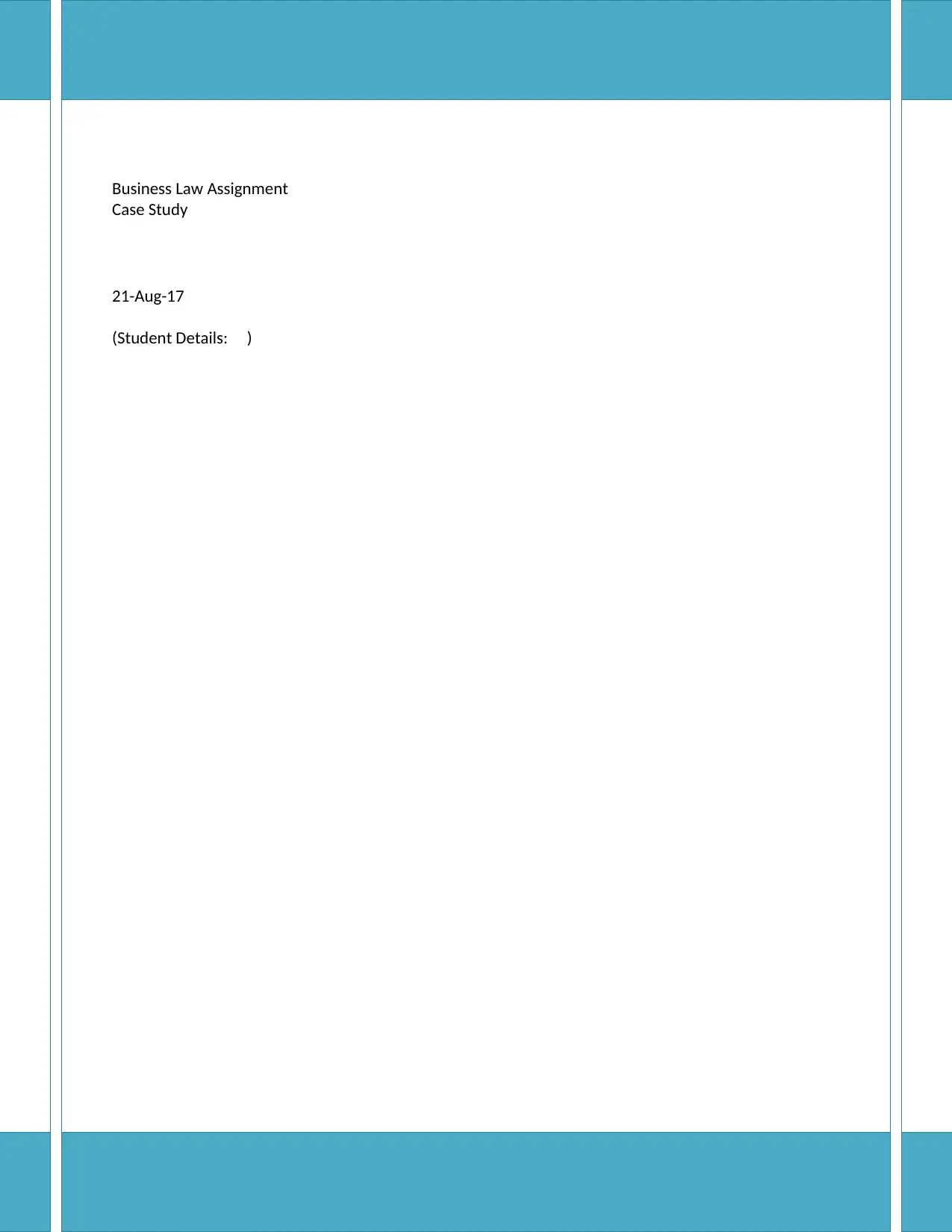
Business Law Assignment
Case Study
21-Aug-17
(Student Details: )
Case Study
21-Aug-17
(Student Details: )
Secure Best Marks with AI Grader
Need help grading? Try our AI Grader for instant feedback on your assignments.
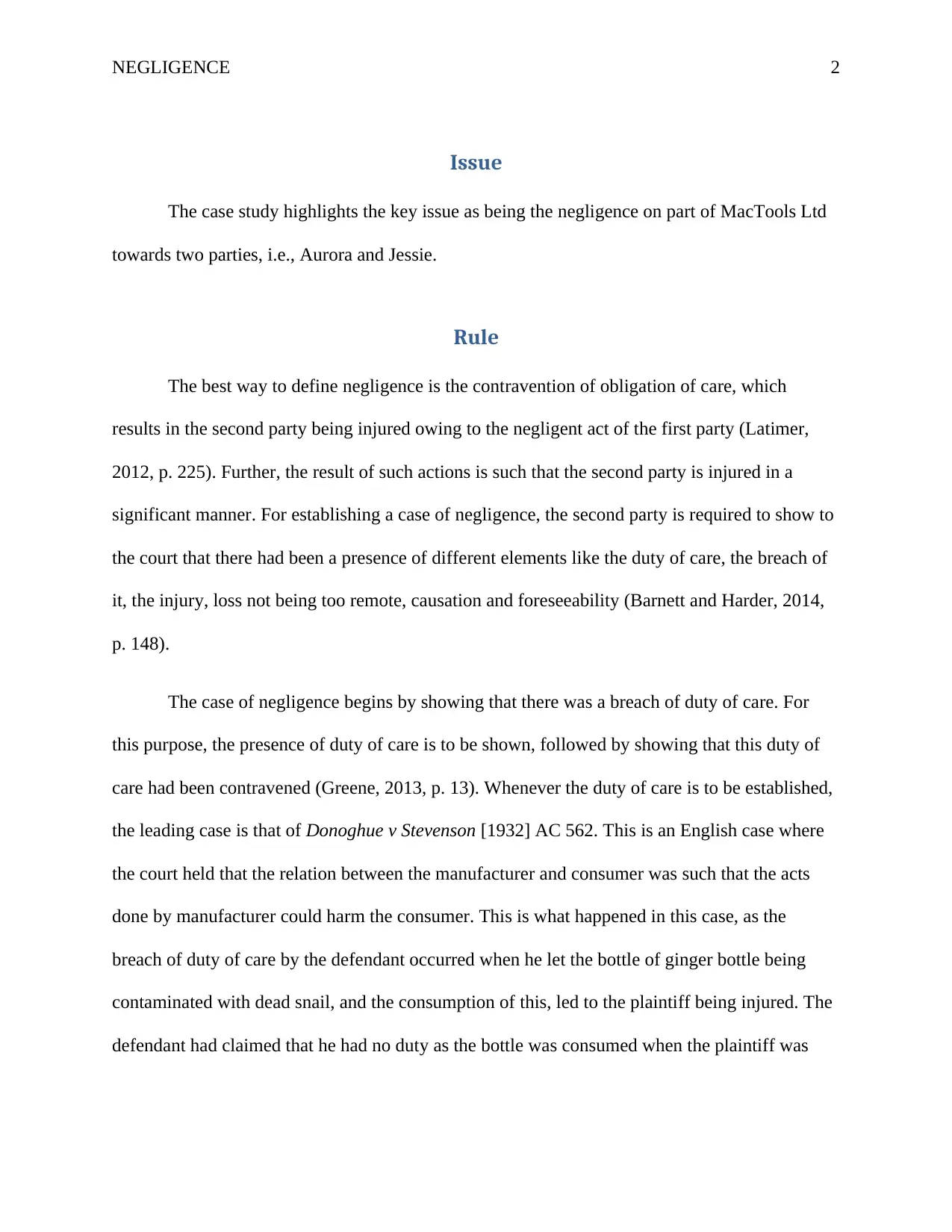
NEGLIGENCE 2
Issue
The case study highlights the key issue as being the negligence on part of MacTools Ltd
towards two parties, i.e., Aurora and Jessie.
Rule
The best way to define negligence is the contravention of obligation of care, which
results in the second party being injured owing to the negligent act of the first party (Latimer,
2012, p. 225). Further, the result of such actions is such that the second party is injured in a
significant manner. For establishing a case of negligence, the second party is required to show to
the court that there had been a presence of different elements like the duty of care, the breach of
it, the injury, loss not being too remote, causation and foreseeability (Barnett and Harder, 2014,
p. 148).
The case of negligence begins by showing that there was a breach of duty of care. For
this purpose, the presence of duty of care is to be shown, followed by showing that this duty of
care had been contravened (Greene, 2013, p. 13). Whenever the duty of care is to be established,
the leading case is that of Donoghue v Stevenson [1932] AC 562. This is an English case where
the court held that the relation between the manufacturer and consumer was such that the acts
done by manufacturer could harm the consumer. This is what happened in this case, as the
breach of duty of care by the defendant occurred when he let the bottle of ginger bottle being
contaminated with dead snail, and the consumption of this, led to the plaintiff being injured. The
defendant had claimed that he had no duty as the bottle was consumed when the plaintiff was
Issue
The case study highlights the key issue as being the negligence on part of MacTools Ltd
towards two parties, i.e., Aurora and Jessie.
Rule
The best way to define negligence is the contravention of obligation of care, which
results in the second party being injured owing to the negligent act of the first party (Latimer,
2012, p. 225). Further, the result of such actions is such that the second party is injured in a
significant manner. For establishing a case of negligence, the second party is required to show to
the court that there had been a presence of different elements like the duty of care, the breach of
it, the injury, loss not being too remote, causation and foreseeability (Barnett and Harder, 2014,
p. 148).
The case of negligence begins by showing that there was a breach of duty of care. For
this purpose, the presence of duty of care is to be shown, followed by showing that this duty of
care had been contravened (Greene, 2013, p. 13). Whenever the duty of care is to be established,
the leading case is that of Donoghue v Stevenson [1932] AC 562. This is an English case where
the court held that the relation between the manufacturer and consumer was such that the acts
done by manufacturer could harm the consumer. This is what happened in this case, as the
breach of duty of care by the defendant occurred when he let the bottle of ginger bottle being
contaminated with dead snail, and the consumption of this, led to the plaintiff being injured. The
defendant had claimed that he had no duty as the bottle was consumed when the plaintiff was
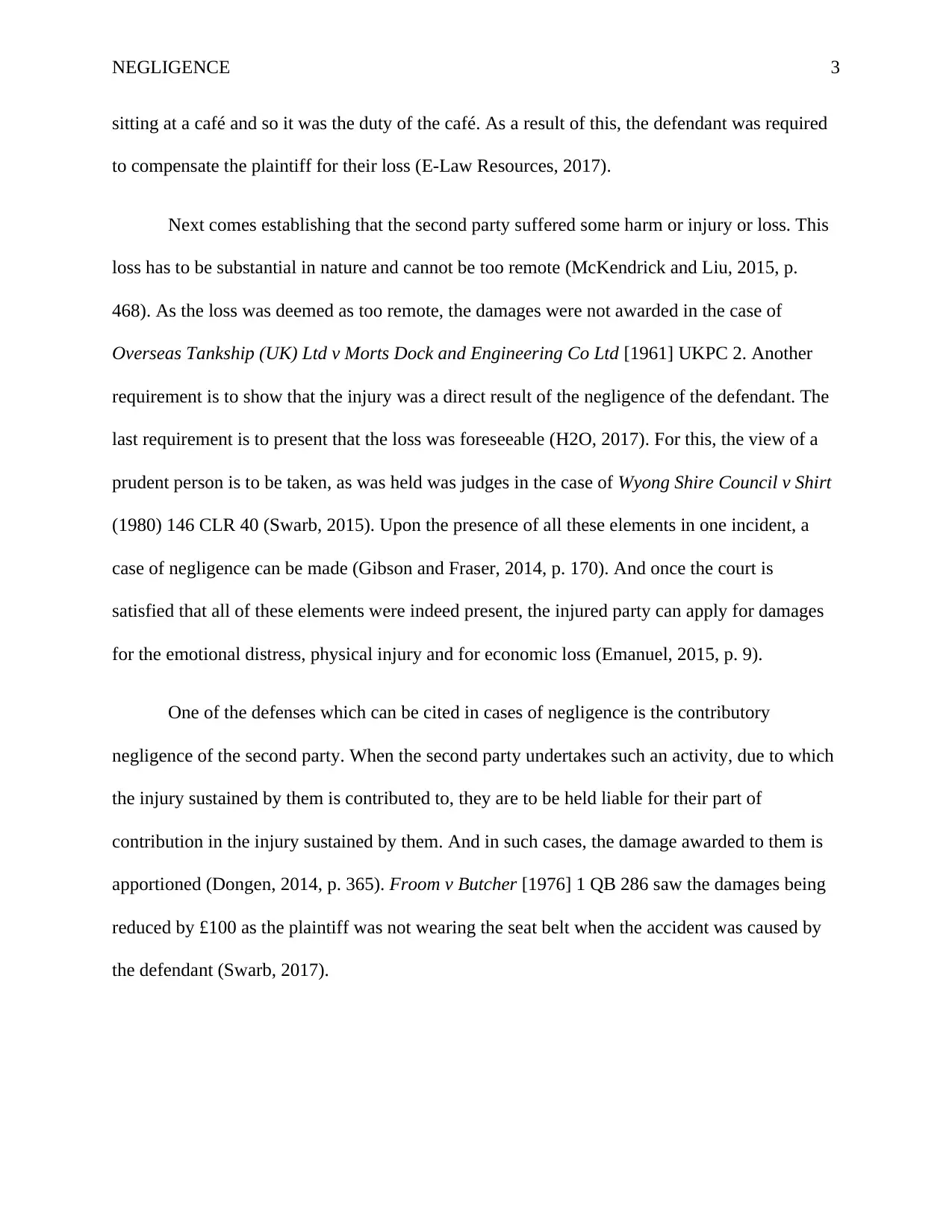
NEGLIGENCE 3
sitting at a café and so it was the duty of the café. As a result of this, the defendant was required
to compensate the plaintiff for their loss (E-Law Resources, 2017).
Next comes establishing that the second party suffered some harm or injury or loss. This
loss has to be substantial in nature and cannot be too remote (McKendrick and Liu, 2015, p.
468). As the loss was deemed as too remote, the damages were not awarded in the case of
Overseas Tankship (UK) Ltd v Morts Dock and Engineering Co Ltd [1961] UKPC 2. Another
requirement is to show that the injury was a direct result of the negligence of the defendant. The
last requirement is to present that the loss was foreseeable (H2O, 2017). For this, the view of a
prudent person is to be taken, as was held was judges in the case of Wyong Shire Council v Shirt
(1980) 146 CLR 40 (Swarb, 2015). Upon the presence of all these elements in one incident, a
case of negligence can be made (Gibson and Fraser, 2014, p. 170). And once the court is
satisfied that all of these elements were indeed present, the injured party can apply for damages
for the emotional distress, physical injury and for economic loss (Emanuel, 2015, p. 9).
One of the defenses which can be cited in cases of negligence is the contributory
negligence of the second party. When the second party undertakes such an activity, due to which
the injury sustained by them is contributed to, they are to be held liable for their part of
contribution in the injury sustained by them. And in such cases, the damage awarded to them is
apportioned (Dongen, 2014, p. 365). Froom v Butcher [1976] 1 QB 286 saw the damages being
reduced by £100 as the plaintiff was not wearing the seat belt when the accident was caused by
the defendant (Swarb, 2017).
sitting at a café and so it was the duty of the café. As a result of this, the defendant was required
to compensate the plaintiff for their loss (E-Law Resources, 2017).
Next comes establishing that the second party suffered some harm or injury or loss. This
loss has to be substantial in nature and cannot be too remote (McKendrick and Liu, 2015, p.
468). As the loss was deemed as too remote, the damages were not awarded in the case of
Overseas Tankship (UK) Ltd v Morts Dock and Engineering Co Ltd [1961] UKPC 2. Another
requirement is to show that the injury was a direct result of the negligence of the defendant. The
last requirement is to present that the loss was foreseeable (H2O, 2017). For this, the view of a
prudent person is to be taken, as was held was judges in the case of Wyong Shire Council v Shirt
(1980) 146 CLR 40 (Swarb, 2015). Upon the presence of all these elements in one incident, a
case of negligence can be made (Gibson and Fraser, 2014, p. 170). And once the court is
satisfied that all of these elements were indeed present, the injured party can apply for damages
for the emotional distress, physical injury and for economic loss (Emanuel, 2015, p. 9).
One of the defenses which can be cited in cases of negligence is the contributory
negligence of the second party. When the second party undertakes such an activity, due to which
the injury sustained by them is contributed to, they are to be held liable for their part of
contribution in the injury sustained by them. And in such cases, the damage awarded to them is
apportioned (Dongen, 2014, p. 365). Froom v Butcher [1976] 1 QB 286 saw the damages being
reduced by £100 as the plaintiff was not wearing the seat belt when the accident was caused by
the defendant (Swarb, 2017).
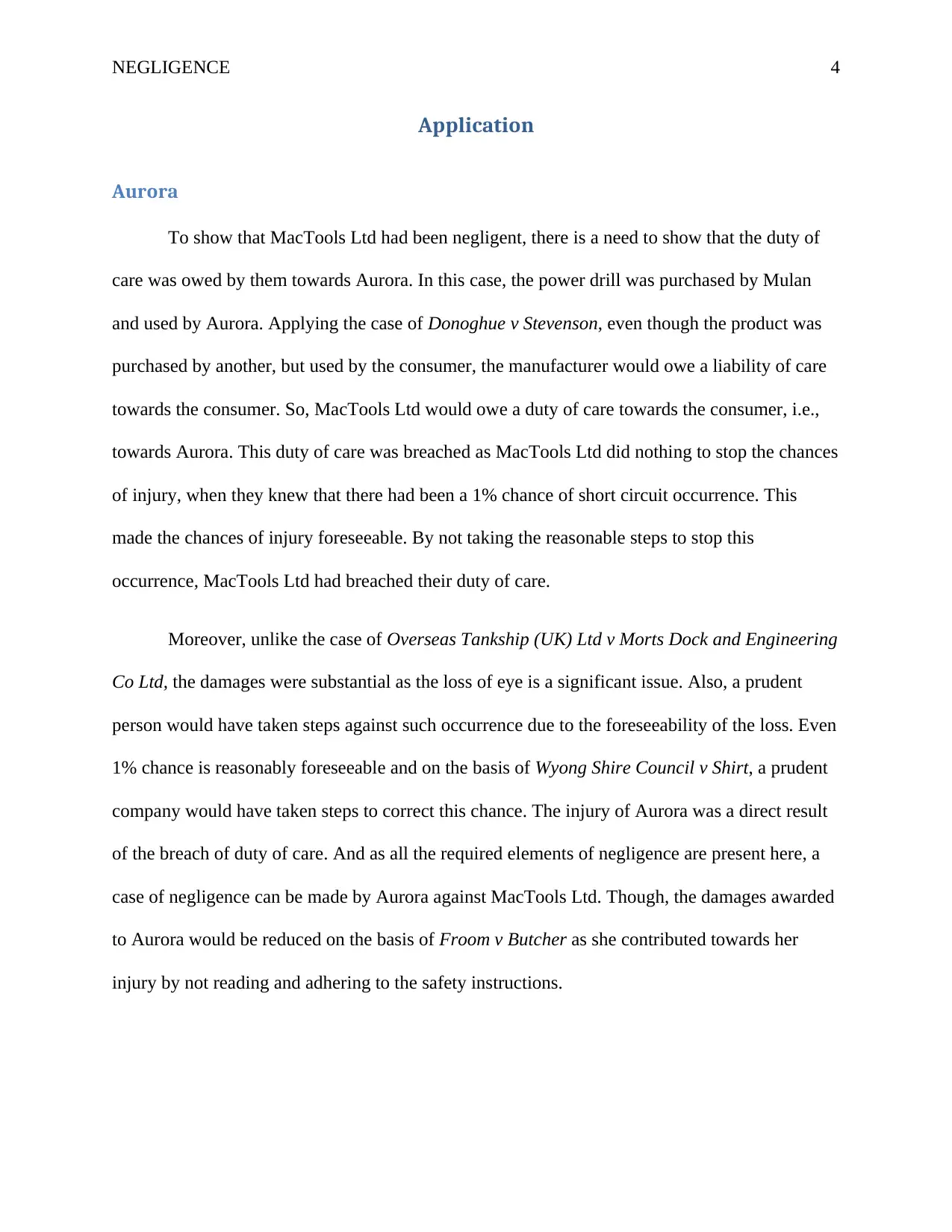
NEGLIGENCE 4
Application
Aurora
To show that MacTools Ltd had been negligent, there is a need to show that the duty of
care was owed by them towards Aurora. In this case, the power drill was purchased by Mulan
and used by Aurora. Applying the case of Donoghue v Stevenson, even though the product was
purchased by another, but used by the consumer, the manufacturer would owe a liability of care
towards the consumer. So, MacTools Ltd would owe a duty of care towards the consumer, i.e.,
towards Aurora. This duty of care was breached as MacTools Ltd did nothing to stop the chances
of injury, when they knew that there had been a 1% chance of short circuit occurrence. This
made the chances of injury foreseeable. By not taking the reasonable steps to stop this
occurrence, MacTools Ltd had breached their duty of care.
Moreover, unlike the case of Overseas Tankship (UK) Ltd v Morts Dock and Engineering
Co Ltd, the damages were substantial as the loss of eye is a significant issue. Also, a prudent
person would have taken steps against such occurrence due to the foreseeability of the loss. Even
1% chance is reasonably foreseeable and on the basis of Wyong Shire Council v Shirt, a prudent
company would have taken steps to correct this chance. The injury of Aurora was a direct result
of the breach of duty of care. And as all the required elements of negligence are present here, a
case of negligence can be made by Aurora against MacTools Ltd. Though, the damages awarded
to Aurora would be reduced on the basis of Froom v Butcher as she contributed towards her
injury by not reading and adhering to the safety instructions.
Application
Aurora
To show that MacTools Ltd had been negligent, there is a need to show that the duty of
care was owed by them towards Aurora. In this case, the power drill was purchased by Mulan
and used by Aurora. Applying the case of Donoghue v Stevenson, even though the product was
purchased by another, but used by the consumer, the manufacturer would owe a liability of care
towards the consumer. So, MacTools Ltd would owe a duty of care towards the consumer, i.e.,
towards Aurora. This duty of care was breached as MacTools Ltd did nothing to stop the chances
of injury, when they knew that there had been a 1% chance of short circuit occurrence. This
made the chances of injury foreseeable. By not taking the reasonable steps to stop this
occurrence, MacTools Ltd had breached their duty of care.
Moreover, unlike the case of Overseas Tankship (UK) Ltd v Morts Dock and Engineering
Co Ltd, the damages were substantial as the loss of eye is a significant issue. Also, a prudent
person would have taken steps against such occurrence due to the foreseeability of the loss. Even
1% chance is reasonably foreseeable and on the basis of Wyong Shire Council v Shirt, a prudent
company would have taken steps to correct this chance. The injury of Aurora was a direct result
of the breach of duty of care. And as all the required elements of negligence are present here, a
case of negligence can be made by Aurora against MacTools Ltd. Though, the damages awarded
to Aurora would be reduced on the basis of Froom v Butcher as she contributed towards her
injury by not reading and adhering to the safety instructions.
Secure Best Marks with AI Grader
Need help grading? Try our AI Grader for instant feedback on your assignments.
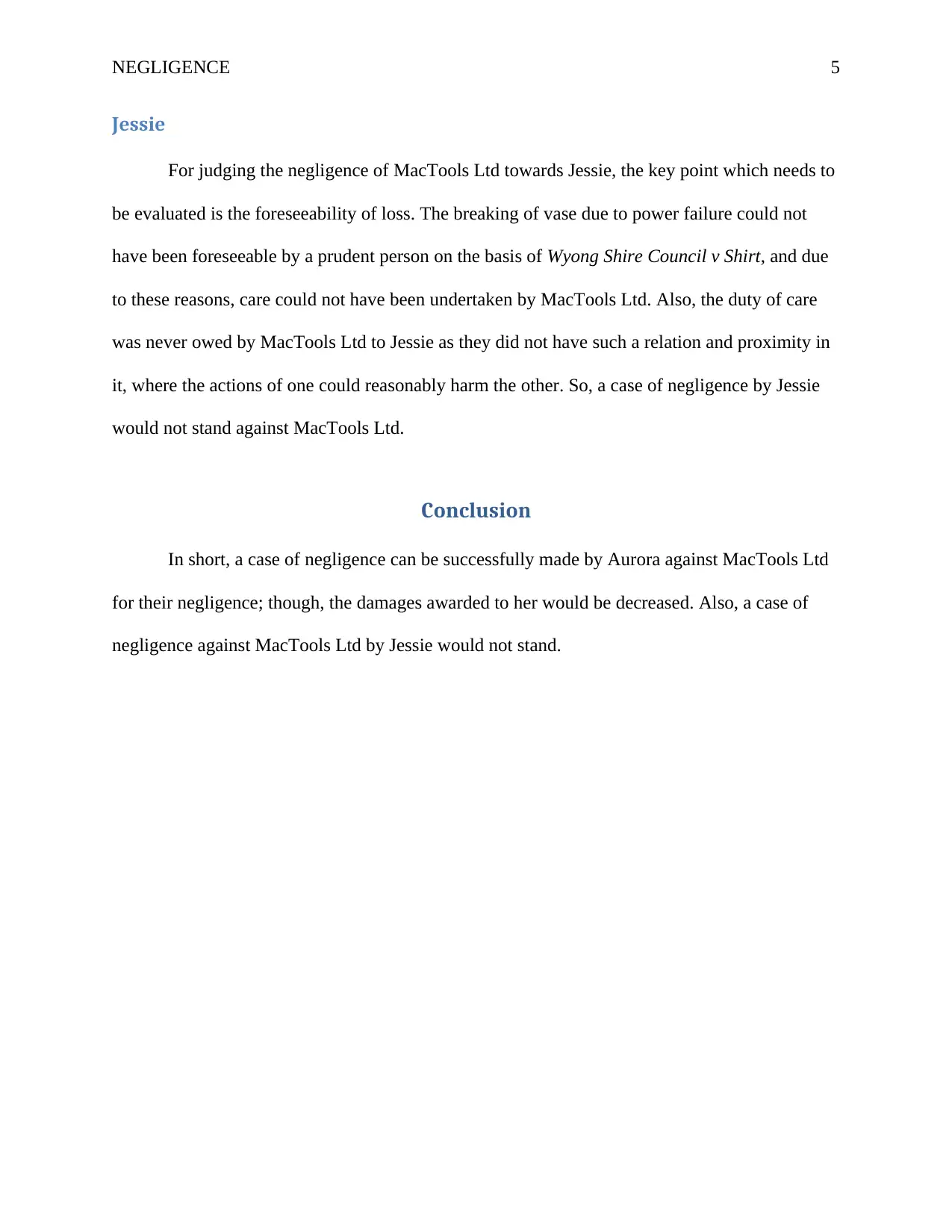
NEGLIGENCE 5
Jessie
For judging the negligence of MacTools Ltd towards Jessie, the key point which needs to
be evaluated is the foreseeability of loss. The breaking of vase due to power failure could not
have been foreseeable by a prudent person on the basis of Wyong Shire Council v Shirt, and due
to these reasons, care could not have been undertaken by MacTools Ltd. Also, the duty of care
was never owed by MacTools Ltd to Jessie as they did not have such a relation and proximity in
it, where the actions of one could reasonably harm the other. So, a case of negligence by Jessie
would not stand against MacTools Ltd.
Conclusion
In short, a case of negligence can be successfully made by Aurora against MacTools Ltd
for their negligence; though, the damages awarded to her would be decreased. Also, a case of
negligence against MacTools Ltd by Jessie would not stand.
Jessie
For judging the negligence of MacTools Ltd towards Jessie, the key point which needs to
be evaluated is the foreseeability of loss. The breaking of vase due to power failure could not
have been foreseeable by a prudent person on the basis of Wyong Shire Council v Shirt, and due
to these reasons, care could not have been undertaken by MacTools Ltd. Also, the duty of care
was never owed by MacTools Ltd to Jessie as they did not have such a relation and proximity in
it, where the actions of one could reasonably harm the other. So, a case of negligence by Jessie
would not stand against MacTools Ltd.
Conclusion
In short, a case of negligence can be successfully made by Aurora against MacTools Ltd
for their negligence; though, the damages awarded to her would be decreased. Also, a case of
negligence against MacTools Ltd by Jessie would not stand.
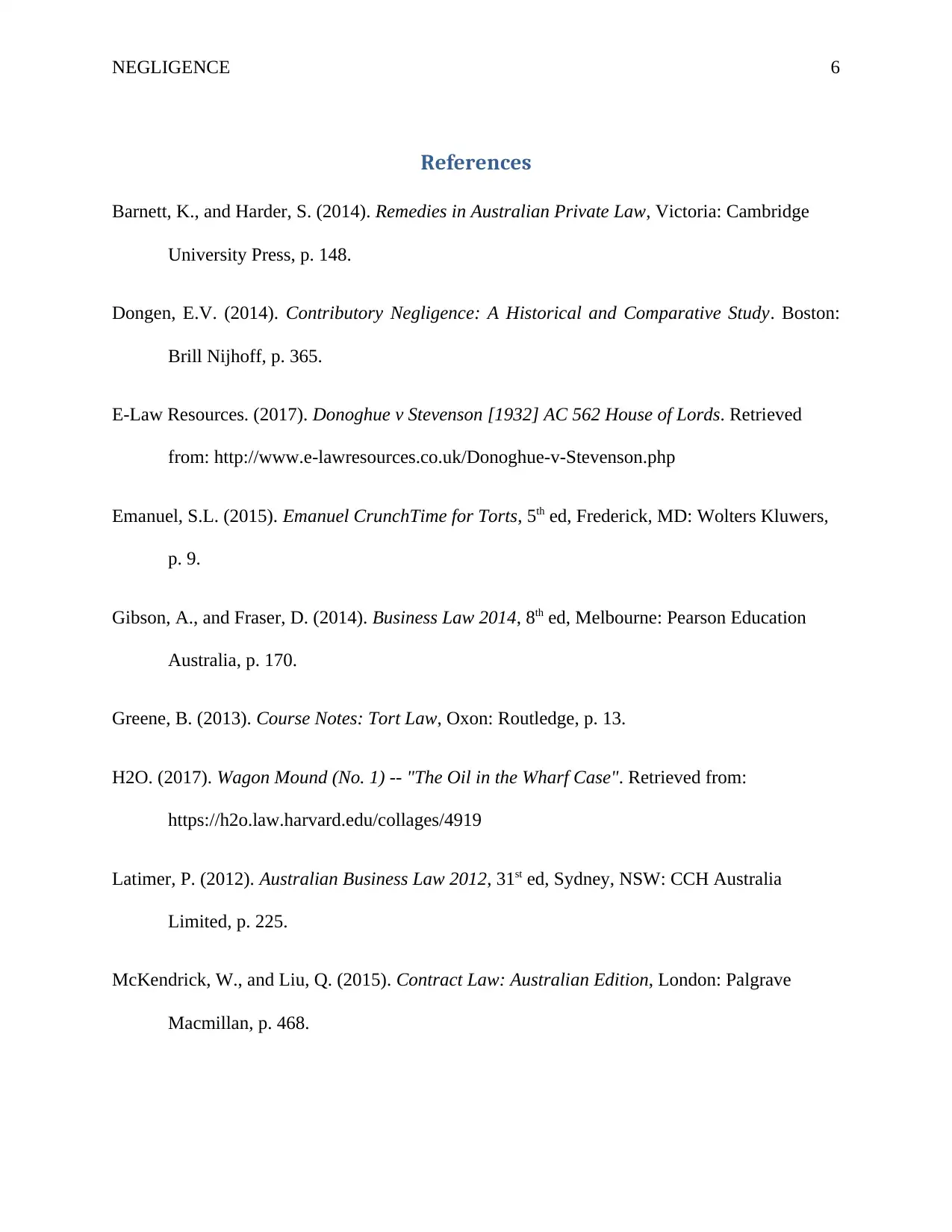
NEGLIGENCE 6
References
Barnett, K., and Harder, S. (2014). Remedies in Australian Private Law, Victoria: Cambridge
University Press, p. 148.
Dongen, E.V. (2014). Contributory Negligence: A Historical and Comparative Study. Boston:
Brill Nijhoff, p. 365.
E-Law Resources. (2017). Donoghue v Stevenson [1932] AC 562 House of Lords. Retrieved
from: http://www.e-lawresources.co.uk/Donoghue-v-Stevenson.php
Emanuel, S.L. (2015). Emanuel CrunchTime for Torts, 5th ed, Frederick, MD: Wolters Kluwers,
p. 9.
Gibson, A., and Fraser, D. (2014). Business Law 2014, 8th ed, Melbourne: Pearson Education
Australia, p. 170.
Greene, B. (2013). Course Notes: Tort Law, Oxon: Routledge, p. 13.
H2O. (2017). Wagon Mound (No. 1) -- "The Oil in the Wharf Case". Retrieved from:
https://h2o.law.harvard.edu/collages/4919
Latimer, P. (2012). Australian Business Law 2012, 31st ed, Sydney, NSW: CCH Australia
Limited, p. 225.
McKendrick, W., and Liu, Q. (2015). Contract Law: Australian Edition, London: Palgrave
Macmillan, p. 468.
References
Barnett, K., and Harder, S. (2014). Remedies in Australian Private Law, Victoria: Cambridge
University Press, p. 148.
Dongen, E.V. (2014). Contributory Negligence: A Historical and Comparative Study. Boston:
Brill Nijhoff, p. 365.
E-Law Resources. (2017). Donoghue v Stevenson [1932] AC 562 House of Lords. Retrieved
from: http://www.e-lawresources.co.uk/Donoghue-v-Stevenson.php
Emanuel, S.L. (2015). Emanuel CrunchTime for Torts, 5th ed, Frederick, MD: Wolters Kluwers,
p. 9.
Gibson, A., and Fraser, D. (2014). Business Law 2014, 8th ed, Melbourne: Pearson Education
Australia, p. 170.
Greene, B. (2013). Course Notes: Tort Law, Oxon: Routledge, p. 13.
H2O. (2017). Wagon Mound (No. 1) -- "The Oil in the Wharf Case". Retrieved from:
https://h2o.law.harvard.edu/collages/4919
Latimer, P. (2012). Australian Business Law 2012, 31st ed, Sydney, NSW: CCH Australia
Limited, p. 225.
McKendrick, W., and Liu, Q. (2015). Contract Law: Australian Edition, London: Palgrave
Macmillan, p. 468.
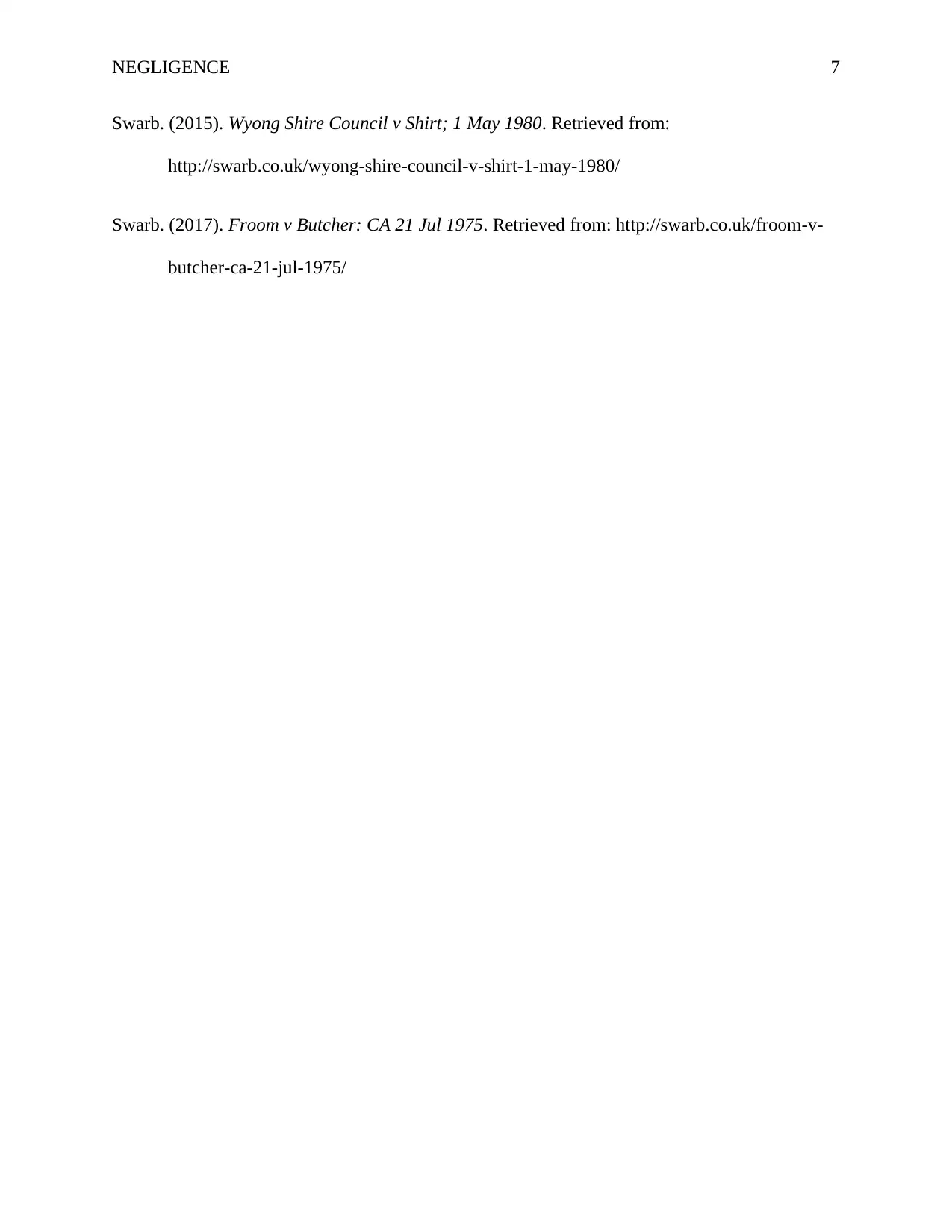
NEGLIGENCE 7
Swarb. (2015). Wyong Shire Council v Shirt; 1 May 1980. Retrieved from:
http://swarb.co.uk/wyong-shire-council-v-shirt-1-may-1980/
Swarb. (2017). Froom v Butcher: CA 21 Jul 1975. Retrieved from: http://swarb.co.uk/froom-v-
butcher-ca-21-jul-1975/
Swarb. (2015). Wyong Shire Council v Shirt; 1 May 1980. Retrieved from:
http://swarb.co.uk/wyong-shire-council-v-shirt-1-may-1980/
Swarb. (2017). Froom v Butcher: CA 21 Jul 1975. Retrieved from: http://swarb.co.uk/froom-v-
butcher-ca-21-jul-1975/
1 out of 7
Related Documents
Your All-in-One AI-Powered Toolkit for Academic Success.
+13062052269
info@desklib.com
Available 24*7 on WhatsApp / Email
![[object Object]](/_next/static/media/star-bottom.7253800d.svg)
Unlock your academic potential
© 2024 | Zucol Services PVT LTD | All rights reserved.





